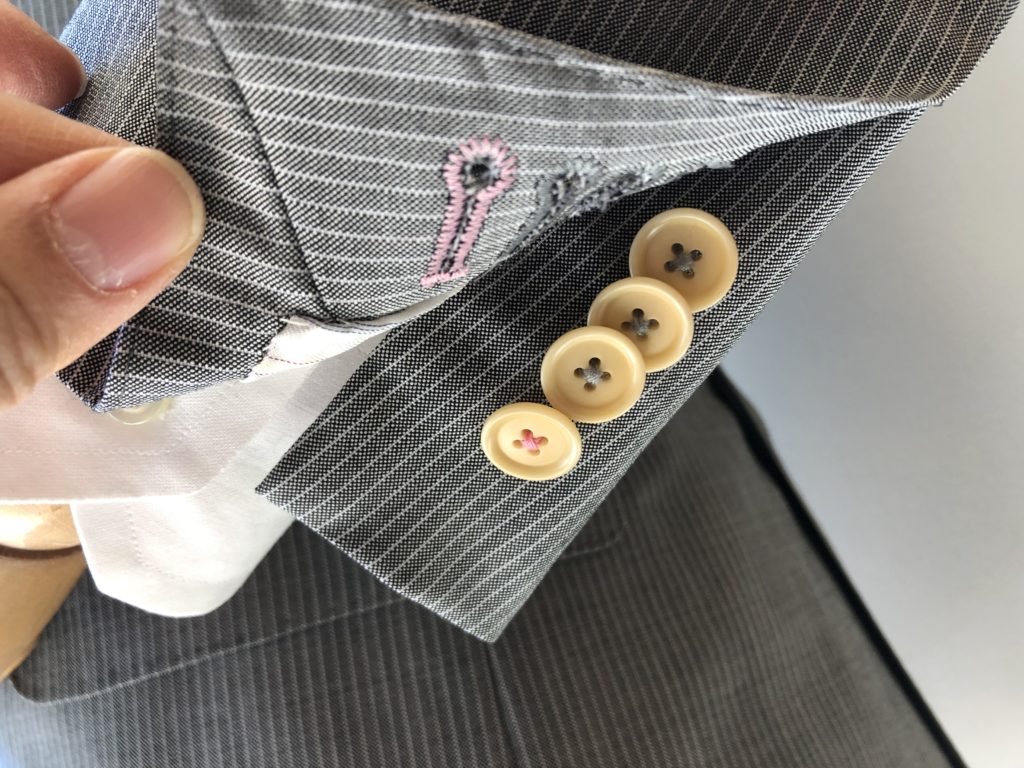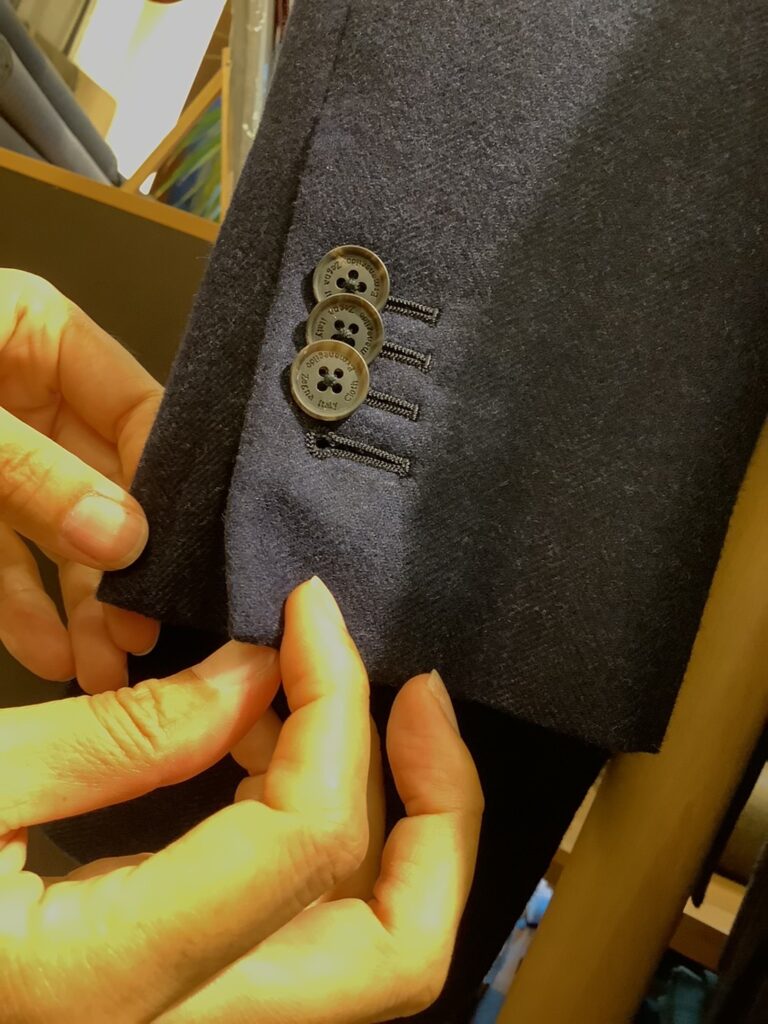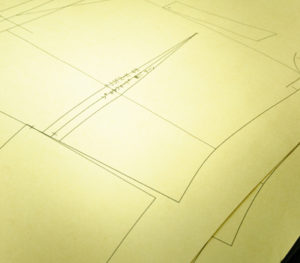ジャケットの袖ボタン穴(本切羽 / Asole Vere)の歴史、変遷、機能について
歴史と起源
ジャケットの袖ボタンが開閉可能な本切羽(イタリア語で「Asole Vere」)は、紳士服の歴史において機能性と美意識が融合した要素の一つです。このディテールの起源は18世紀に遡ります。当時、紳士服は機能性を重視してデザインされており、ジャケットの袖ボタン穴は特に医者にとって実用的な意味を持っていました。
- 医者の着用: 医師が診察時に袖をまくりやすいよう、本切羽が取り入れられたと言われています。この機能により、袖を簡単にロールアップすることで手を清潔に保つ必要があったと言われています。

時代の変遷
19世紀に入ると、本切羽の実用性は徐々に減少し、装飾的な役割が強調されるようになりました。特にヴィクトリア朝時代のイギリスでは、紳士の身だしなみやステータスを象徴するディテールとして注目を集めました。
- 19世紀後半: 工業化が進むにつれて、大量生産された既製服が登場。本切羽はコスト削減のため省略されることが多くなりました。
- 20世紀前半: テーラーメイドやハンドメイドスーツにおいて、本切羽は特別感を演出する高級仕立ての象徴となりました。
- 現代: 高級オーダーメイドスーツや一部の既製服では、本切羽が再び取り入れられています。特にテーラーメイドスーツでは「本物の仕立て」を示すディテールとして評価されています。
機能と美意識
現在の本切羽には以下のような機能性と美意識が込められています:
- 実用性:
- 袖をロールアップできるため、実用的な側面も維持されています。
- 着用者がカジュアルなシーンで袖をまくり、控えめながらもスタイリッシュな個性を見せることが可能です。
- クラフトマンシップの象徴:
- 袖ボタン穴を開閉可能にする技術は、高度な仕立て技術を必要とします。そのため、本切羽は職人の技術力を示す要素となっています。
- ステータスと自己表現:
- 本切羽はテーラーメイドや高級既製服の象徴として、着用者のステータスや審美眼をアピールする手段となっています。
- イタリアでは、袖のボタンをわざと一つ外して本切羽を見せるスタイルが流行し、着用者のこだわりを伝えるアイコンとなっています。
結論
本切羽は、もともと機能的な目的で生まれましたが、時代の変遷とともに装飾的な意味合いを帯び、現代ではクラフトマンシップや高級感を象徴するディテールとして愛されています。この小さなディテールには、ジャケットに込められた伝統と進化、そして美意識の融合が凝縮されているのです。
ヴェスタではイタリアファブリックのスーツに本切羽が標準装備
手縫いの技術の証として、イタリアのテイラリングで象徴的という解釈より、イタリアンファブリックの仕立てディテールに含められています。ブリティッシュは、伝統の軍服を代々受け継ぐ象徴を解釈し、あえてボタンホールは開けない仕様が標準です。それぞれの持ち味をお楽しみください。(ブリティッシュで本切羽がご希望の方はオプションでお受けいたします。)
豪華ディテールは全て込み!ヴェスタ仕立ての標準スペックはこちらから
ご来店ご予約はこちらから
オンラインご予約サイトが便利です。
https://vestayoyaku.youcanbook.me
お電話:03−3562−0362
ご不明な点はいつでもお電話や、VESTA公式Line, Instagram のDMでご相談ください。
History, Evolution, and Functionality of Jacket Sleeve Buttonholes (Asole Vere)
History and Origin
Jacket sleeve buttonholes that can be opened and closed, known in Japanese as “Honseppa” and in Italian as “Asole Vere,” represent a fusion of functionality and aesthetics in menswear history. The origins of this detail date back to the 18th century when menswear was designed with a strong emphasis on practicality. Sleeve buttonholes on jackets held particular significance for doctors.
- Worn by Doctors: It is said that doctors incorporated functional sleeve buttonholes so they could easily roll up their sleeves during examinations, keeping their hands clean and maintaining hygiene.
Evolution Over Time
By the 19th century, the practical utility of functional sleeve buttonholes gradually diminished, and their decorative significance became more prominent. During the Victorian era in England, they became a symbol of a gentleman’s grooming and status.
- Late 19th Century: With the advent of industrialization, mass-produced ready-to-wear clothing emerged. To cut costs, functional buttonholes were often omitted.
- Early 20th Century: In tailor-made and handmade suits, functional sleeve buttonholes became a hallmark of superior craftsmanship and exclusivity.
- Modern Era: Functional sleeve buttonholes have regained popularity in high-end bespoke tailoring and some premium ready-to-wear brands. In custom suits, they signify “genuine craftsmanship.”
Functionality and Aesthetic Value
Today, functional sleeve buttonholes embody both practical and aesthetic elements:
- Practicality:
- Wearers can roll up their sleeves when needed, preserving some of the original practical function.
- In casual settings, unbuttoning a sleeve button subtly showcases a sense of personal style.
- Symbol of Craftsmanship:
- Creating functional sleeve buttonholes requires advanced tailoring techniques, making them a testament to the artisan’s skill.
- Status and Self-Expression:
- Functional sleeve buttonholes are an emblem of bespoke tailoring and high-end ready-to-wear suits, reflecting the wearer’s refined taste.
- In Italy, it has become a style statement to intentionally leave one button undone, subtly showcasing attention to sartorial detail.
VESTA’s Standard for Italian Fabric Suits
At VESTA, functional sleeve buttonholes (Honseppa) are a standard feature on suits made with Italian fabrics. Rather than interpreting them as a symbolic feature of Italian tailoring, they are included as part of the detailing in the construction of Italian fabric suits.
British tailoring, on the other hand, follows a different tradition. Since British suits have inherited the heritage of military uniforms, the standard practice is to leave the sleeve buttonholes closed. This distinction allows you to appreciate the unique characteristics of each tailoring tradition. (For those who prefer functional buttonholes in British-style suits, we offer this as an optional customization.)
All Luxurious Details Included! VESTA’s Standard Specifications
For a full overview of VESTA’s tailoring specifications, click here:
Book Your Visit Here Our online booking site is convenient for scheduling an appointment: https://vestayoyaku.youcanbook.me
Phone Inquiries: 03-3562-0362
For any questions, feel free to reach out via phone, VESTA’s official LINE account, or Instagram DM.






